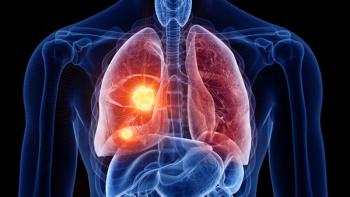
PIK3A-Mutant Breast Cancer Shows Increased Sensitivity to PI3Kα Inhibition
Patients with breast cancer who harbor multiple PIK3A-mutant tumors achieved a higher clinical benefit from PI3Kα inhibition compared with single mutant tumors according to response analysis data from the SANDPIPER trial.
Patients with breast cancer who harbor multiple PIK3A-mutant tumors achieved a higher clinical benefit from PI3Kα inhibition compared with single mutant tumors according to response analysis data from the SANDPIPER trial.
“Double PIK3CA mutations are a novel and frequent genomic alteration in PIK3CA-mutant cancers,” said Neil Vasan, MD, PhD, medical oncologist at Memorial Sloan Kettering Cancer Center in New York, New York during a presentation that the AACR Virtual Annual Meeting II. “These findings confirm that [patients with] breast cancer [with] multiple mutant tumors achieve higher clinical benefit to PI3Kα inhibition compared to single mutant tumors. [The findings] support the rationale to test PI3Kα inhibitors in multiple PIK3CA mutant cancers.”
The phase 3 SANDPIPER trial (NCT02340221) examined the efficacy of taselisib (GDC-0032) plus fulvestrant versus placebo plus fulvestrant in 631 patients with advanced or metastatic ER-positive breast cancer who experienced disease recurrence or progression during or after aromatase inhibitor therapy. Using circulating tumor DNA to detect the presence of a PIK3CA mutation, investigators examined 508 patient samples using Foundation Medicine’s Foundation One Liquid test. Of those tested, 339 patients had PIK3CA mutations. Specifically, 19% (n = 66) of the 339 patients who harbored a PIK3CA mutation presented with 2 or more PIK3CA mutations while the remaining 81% (n = 273) had 1 PIK3CA mutation.
Response data demonstrated that patients with multiple PIK3CA mutations had increased tumor shrinkage on taselisib versus those with a single mutation. Single mutant patients in the taselisib arm (n = 193) had an overall response rate (ORR) of 18.1% versus 10.0% in those treated in the placebo arm (n = 80). The difference was not reported as being statistically significant. Patients with multiple mutations in taselisib arm (n = 43) achieved an ORR of 30.2% versus 8.7% in the placebo arm (n = 23), achieving statistical significance.1
“This was not the primary end point of this trial but certainly this raises the hypothesis based on the best available clinical data that multiple PIK3CA mutations may predict for increased response to PI3K kinase inhibitors,” Vasan said.
“In this work, we have identified double mutations in cis as a novel, and relatively frequent, genomic alteration in PIK3CA, which translates into a clinically meaningful number of patients who may derive additional benefit from targeted therapy,” he added.
Exploring Multiple Mutants
Activating mutations in PIK3CA are the most frequent oncogenic alterations in all cancers, including ER-positive breast cancer. Investigators sought to determine whether there was potential biological relevance and correlation with sensitivity to PI3Kα inhibitors in patients who harbored 1 or more PIK3CA mutations.1
A subgroup analysis of patients with double PIK3CA mutant tumors in the phase 3 SOLAR-1 trial (NCT02437318) served as the launching point for this analysis. SOLAR-1 investigated the efficacy of alpelisib (Piqray) in combination with fulvestrant in men and postmenopausal women with hormone receptor-positive/HER2-negative advanced breast cancer following progression on or after an endocrine-based regimen. Final results from the SOLAR-1 study showed that the alpelisib-containing regimen conferred a progression-free survival benefit in the cohort of patients with PIK3CA mutations. The agent was subsequently approved in combination with fulvestrant on May 24, 2019 for this PIK3CA-mutation harboring patient population.2 Notably, patients with ER-positive breast cancer who had double mutations in PIK3CA were more likely to respond to the combination of the alpelisib with an aromatase inhibitor, Vasan said.
PIK3CA mutations are found in 10% to 15% of all PIK3CA-mutant cancers, including breast cancer, according to results from a genomic analysis of more than 70,000 patients with cancer conducted by Vasan and fellow investigators. In an additional clinical analysis, double PIK3CA-mutant tumors were found just as frequently in the primary setting as they were in the metastatic setting. This analysis of genomic alterations demonstrated that double mutations are not simply the function of therapeutic response or tumor heterogeneity, Vasan noted.1
“Double PIK3CA-mutant tumors are more frequently found in hormone receptor—positive/HER2-negative receptor subtypes compared to other receptor subtypes in breast cancer,” he added.
Next steps included determining whether the presence of cis PIK3CA mutations—those existing on the same allele—may be a predictive biomarker for PI3Kα-inhibitor response. Using single molecule real time sequencing (SMRT-seq) of fresh breast tumor samples, investigators were able to determine that double PIK3CA mutations are in cis on the same allele. “This was the first use of SMRT-seq to phase multiple alterations in solid tumors,” Vasan said.
After examining the frequency of PIK3CA mutations, Vasan found that the most frequent hotspots are E542K, E545K, and H1047R, which collectively account for approximately 40% of PIK3CA mutations in patients. “Cis mutants activate PI3K signaling and growth more than single mutants through a combination of disrupter-binder mechanism, [as well as] increase response to PI3Kα-inhibitors compared to single mutants in breast cancer,” Vasan concluded.
References
1. Vasan N, Razavi P, Johnson JL, et al. Double PIK3CA mutations in cis increase oncogenicity and sensitivity to PI3Kα inhibitors. Presented at: American Association for Cancer Research Virtual Annual Meeting II. June 22-24, 2020. Session VSYNGII. https://www.abstractsonline.com/pp8/#!/9045/presentation/11348
2. FDA approves alpelisib for metastatic breast cancer. FDA. Updated May 28, 2019. Accessed June 24, 2020. https://www.fda.gov/drugs/resources-information-approved-drugs/fda-approves-alpelisib-metastatic-breast-cancer
This article was originally published on OncLive as, "
Newsletter
Knowledge is power. Don’t miss the most recent breakthroughs in cancer care.































































































